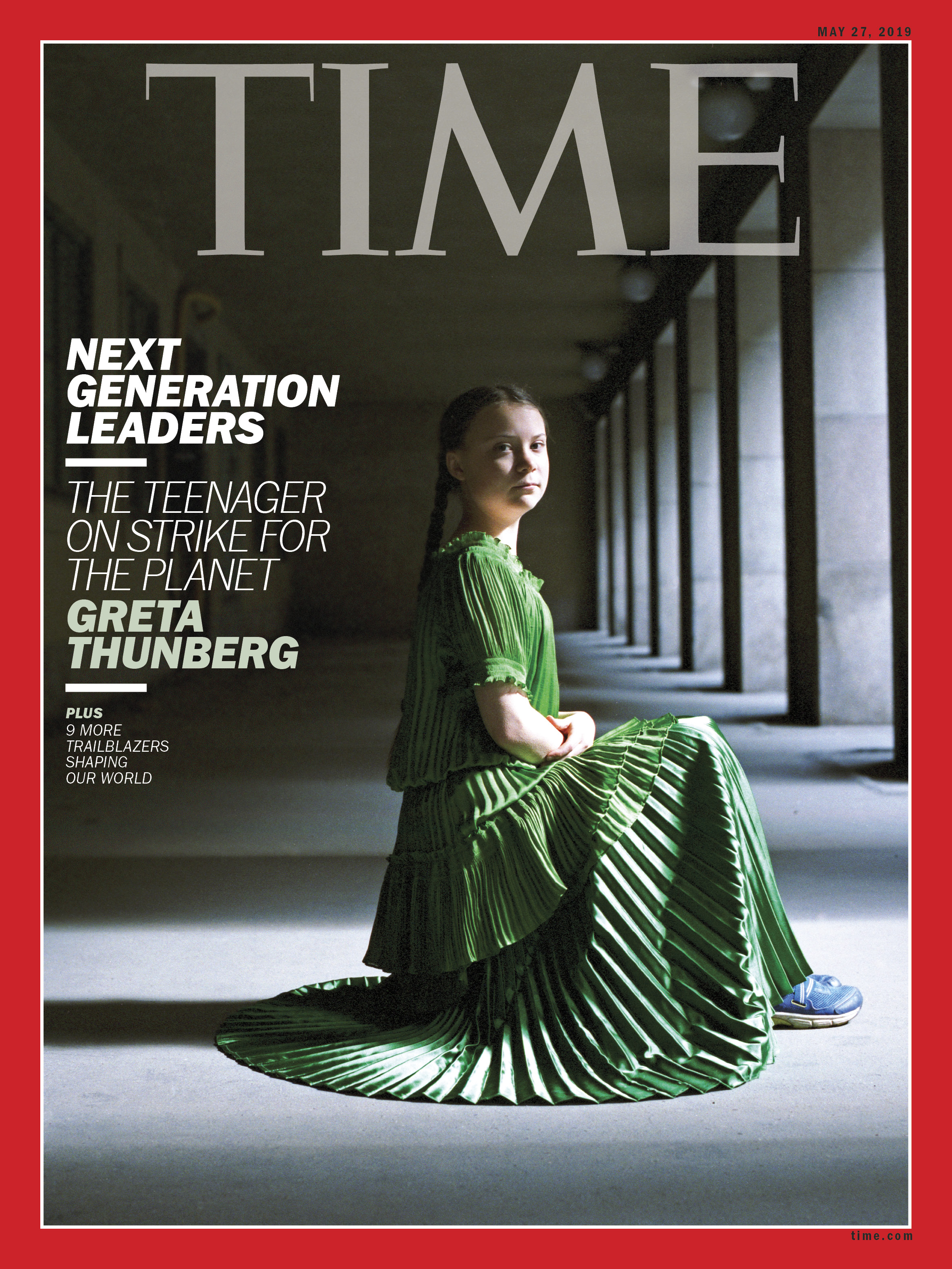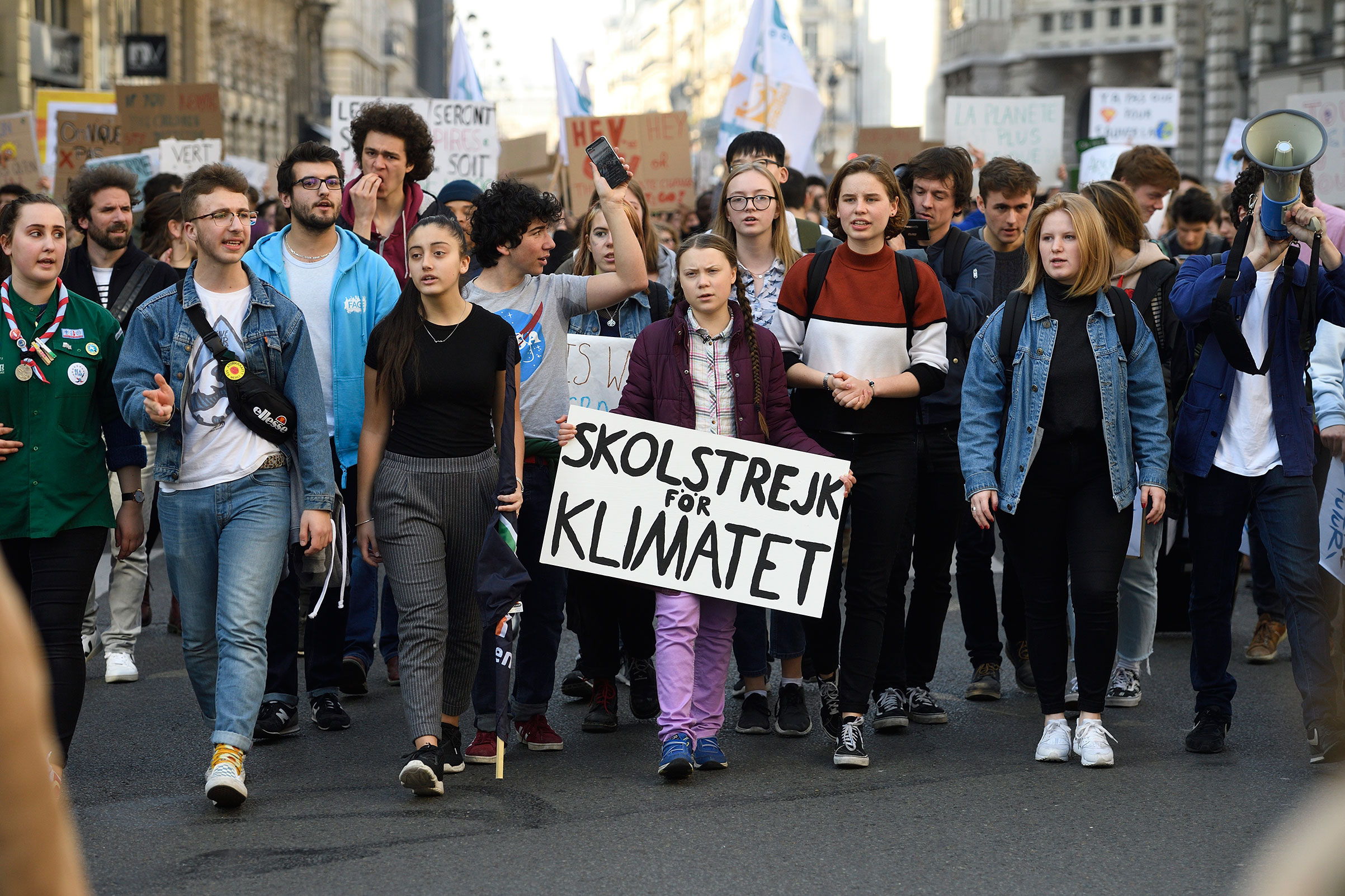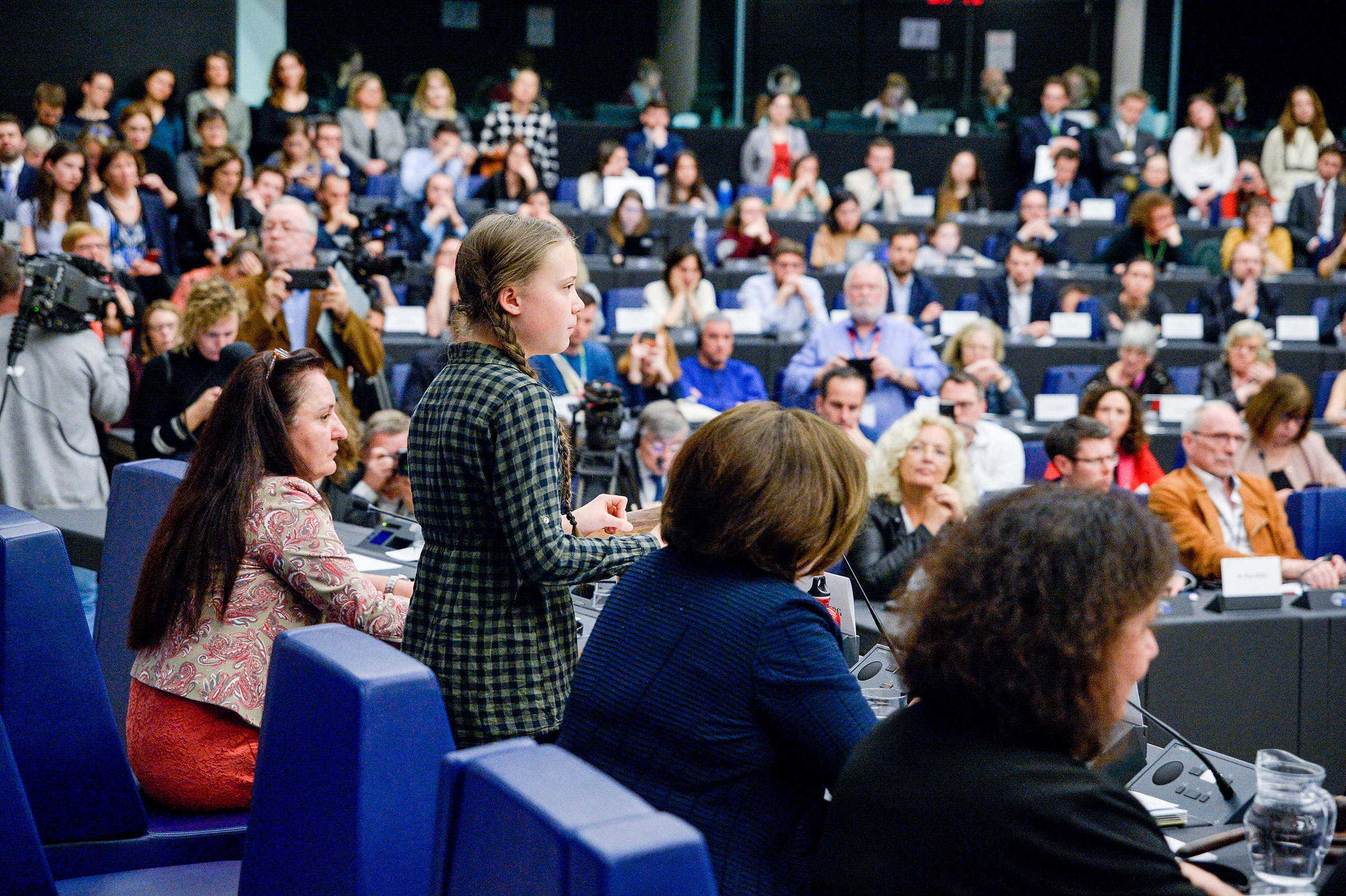“Can you hear me?” Greta Thunberg asks the 150 members and advisers in the U.K. Houses of Parliament. She taps the microphone as if to check if it’s on, but the gesture is meant as a rebuke; she’s asking if they’re listening. She asks again later in her speech. “Did you hear what I just said? Is my English O.K.? Is my microphone on? Because I’m beginning to wonder.” There is laughter, but it’s unclear if it’s amused or awkward. Thunberg is not smiling. She’s here to talk climate; a catastrophe is looming, her generation will bear it, and she knows whom to blame. “You did not act in time,” she declares.
Castigating the powerful has become routine for the 16-year-old. In December, she addressed the U.N. Climate Change Conference in Poland; in January she berated billionaires at the World Economic Forum in Davos, Switzerland. Her London speech was the last stop of a tour that included meeting the Pope. (“Continue to work, continue,” he told her, ending with, “Go along, go ahead.” It was an exhortation, not a dismissal.)
Just nine months ago, Thunberg had no such audiences. She was a lone figure sitting outside the Swedish Parliament in Stockholm, carrying a sign emblazoned with Skolstrejk for Klimatet (School Strike for Climate). She was there for a reason that felt primal and personal. While Thunberg was studying climate change in school at the age of 11, she reacted in a surprisingly intense way: she suffered an episode of severe depression. After a time it lifted, only to resurface last spring.
“I felt everything was meaningless and there was no point going to school if there was no future,” Thunberg says. But this time, rather than suffer the pain, she decided to push back at its cause, channeling her sadness into action. “I promised myself I was going to do everything I could do to make a difference,” she says.
Inspired by the survivors of February 2018’s school shooting in Parkland, Fla., she began a weekly schoolwork strike every Friday, turning to social media to implore politicians to support and take steps toward halting carbon emissions. Since the U.N. Climate Change Conference in December, Thunberg’s Twitter following has grown by nearly 4,000% to reach 612,000; many have also followed her lead offline, striking to demand change. “Before, I never really spoke when I was in my lessons or with my classmates,” she told me shortly after her London speech. “But now I am speaking to the whole world.”

The world is listening. Organizers estimate that on March 15, a remarkable 1.6 million people in 133 countries participated in a climate strike inspired by Thunberg’s solo action—mostly students who walked out of school for a few minutes, an hour or a full day of protest. Since then, the walkouts have continued, with students around the world united by the #FridaysForFuture and #YouthStrike4Climate hashtags. As well as spreading across Europe, the U.S. and Australia, students in Global South countries experiencing severe effects of climate change such as Brazil, Uganda and India have taken action too, following Thunberg’s lead. In the words of Parkland student Emma González, Thunberg’s way of “inspiring steadfast students and shaming apathetic adults” has turned her single idea into a worldwide movement. “There’s a massive intergenerational injustice here,” said 18-year-old U.K. strike organizer Anna Taylor, at the London leg of the global school strike on March 15. “Striking is the only way to make our voices heard.”
As the movement has attracted attention, Thunberg’s life has been transformed. She never expected the whirlwind of interest, saying it was initially tricky to convince other students to join her action. “I just went ahead and decided to plan it, even if I were alone,” she says, with a persistence that has yet to waver.
Thunberg attributes her determination to her diagnosis of Asperger’s, a mild form of autism spectrum disorder. “It makes me see the world differently. I see through lies more easily,” she says. “I don’t like compromising. For me, it’s either you are sustainable or not — you can’t be a little bit sustainable.” Her openness about her diagnosis, and willingness to share about her experiences of depression, anxiety and eating disorders, are another reason why many see Thunberg as a role model. “To be different is not a weakness. It’s a strength in many ways, because you stand out from the crowd.”
Not that all of the attention has made her terribly impressed. She indulges a brief smile at a mention of President Barack Obama’s tweet in praise of her, but she returns quickly to her larger message. “I believe that once we start behaving as if we were in an existential crisis, then we can avoid a climate and ecological breakdown,” she says. “But the opportunity to do so will not last for long. We have to start today.”

After the round of European appearances in April, I join Thunberg and her father Svante on the two-day, 1,200-mile journey back to Stockholm from London. As one of our trains prepares to depart from Brussels at 6:25 a.m., she takes a photo to share with her 1.6 million Instagram followers before putting on an eye mask for a nap. Five minutes into the journey, a man stops to ask if he can take a photo with the sleeping teenager, saying she has inspired his own daughters. Svante politely replies, “When she wakes up, in Cologne.”
There’s a certain retro glamour in the phrase—redolent of an era when train travel was an elegant indulgence, rather than a time-consuming headache compared with going by air. But for Thunberg, the cost in convenience is marginal compared to the greater savings in carbon emissions. She’s not alone. In what her father jokingly calls the “Greta effect,” German and Swedish rail operators have reported a year-on-year rise in passenger numbers. Moreover, Swedish airports have seen fewer flyers since September, in part attributed to a phenomenon Swedes call flygskam, or “flying shame.”
It’s impossible to know if travelers with places to be and schedules to keep are really following the lead of a 16-year-old, but Thunberg is widely credited with setting an example. “People are taking their cues from Greta,” says Naomi Klein, activist and author of This Changes Everything: Capitalism vs. the Climate. “There’s something very hard to categorize about her, and I think because she’s not looking for approval and is not easily impressed, people don’t know what to do with that.”
Thunberg has been greatly influenced by Klein’s work and has welcomed her support. But Klein thinks the teenager doesn’t really need anyone’s advice. “I don’t think I would deign to tell Greta what she should do in the future. She is following her own path with such clarity, and she has tremendously good instincts.”

Thunberg’s main goal is for governments to reduce emissions in line with the Paris Agreement, limiting global temperature rise to 1.5°C over pre-industrial levels. In October 2018, the U.N.’s Intergovernmental Panel on Climate Change (IPCC) released a landmark report warning that carbon emissions would need to be cut by 45% by 2030 to reach this target. “The report made it very clear that we have to act now,” says Myles Allen, a co-author of the report. Since the price of failing to heed these warnings will be paid by young people, Thunberg believes the school strike follows an inevitable logic. “We are children, saying why should we care about our future when no one else is doing that?” she says. “When children say something like that, I think adults feel very bad.”
We arrive at Thunberg’s school 10 minutes late for class, barely two hours after stepping off the train at Stockholm Central and stopping briefly at home for breakfast. Paradoxically, while ditching school is the animating action of Thunberg’s campaign, working hard in class has become an oasis. Conjugating verbs in French class and trying out different instruments in a music lesson have a certain familiarity that addressing Popes and Presidents doesn’t. Glimmers of the surreal outside world appear occasionally—Thunberg has had the peculiar experience of quoting herself when answering questions on current affairs in class—but life at home is mostly unremarkable. In her spare time, she likes cooking vegan food and playing with her two dogs. “Sometimes I feel like it’s not happening, because it’s like two completely different worlds. Here I am just a quiet girl, and there I am very famous,” she says during a break on a school playground, surrounded by woodland.
She manages to live in both worlds, studying for a test and then writing a speech, finishing her homework and organizing a strike. Unlike most global figures, Thunberg doesn’t have a staff; her parents do what they can to maintain a sense of normalcy for her and her 13-year-old sister, Beata, though Svante no longer answers the phone unless it’s a trusted contact.
Meantime, there is a Greta effect within the home too. Svante and Thunberg’s mother Malena Ernman have given up meat, installed solar panels on their home and stopped traveling by air—decisions they made because they tired of arguments with their stubborn daughter, Svante likes to joke. It’s been a major shift for Malena, an opera singer who no longer flies abroad to performances. “Once she realized the consequences of that lifestyle, she was easy to convince,” Thunberg says, sounding more like a parent than a child.

She and her fellow youth strikers in Stockholm are planning for the city’s next major strike on Friday, May 24, two days before the 2019 European Parliament elections. After that, she will pack her bags again to continue spreading the word. A trip to the U.S. seems unlikely for now, given the difficulties of crossing the Atlantic without an airplane. But nothing is impossible for Thunberg, as we ponder the logistics of how she might eventually travel to China one day via the Trans-Siberian railway.
I end my week with Thunberg as she participates in a strike outside the Swedish Parliament on a sunny Friday, where a crowd of around 100 people come and go, joining the strike throughout the day. The group includes people of all ages, from a 10-year-old girl who spent a week making her own replica of Thunberg’s sign, to a group of grandparents who met through joining the strike. Thunberg is still exhausted from her European trip, but she feels comfortable here—among people passionate about environmental issues, speaking democratically about their ideas. She knows action on climate change won’t happen instantly, but she’s prepared to dedicate years to this cause, even if life in the public eye has its drawbacks. “When I grow up, I want to be able to look back and say that I did everything I could,” she says. “I think that more people should feel like that.”
Since she came to prominence, Thunberg has been the target of negativity, trolling and even threats. Right-wing commentators and climate-change deniers have called her a “PR puppet” who is paid by a global network of billionaires to spread a “left-liberal” message. Others have criticized her stern appearance and “monotone voice,” a characteristic shared by many on the autism spectrum.
“It’s quite hilarious when the only thing people can do is mock you, or talk about your appearance or personality, as it means they have no argument, or nothing else to say,” she says, reading some negative replies she’s received to a recent tweet. “I’m not going to let that stop me,” she says, “because I know this is so much more important.”
- The 100 Most Influential People of 2024
- Coco Gauff Is Playing for Herself Now
- Scenes From Pro-Palestinian Encampments Across U.S. Universities
- 6 Compliments That Land Every Time
- If You're Dating Right Now, You're Brave: Column
- The AI That Could Heal a Divided Internet
- Fallout Is a Brilliant Model for the Future of Video Game Adaptations
- Want Weekly Recs on What to Watch, Read, and More? Sign Up for Worth Your Time